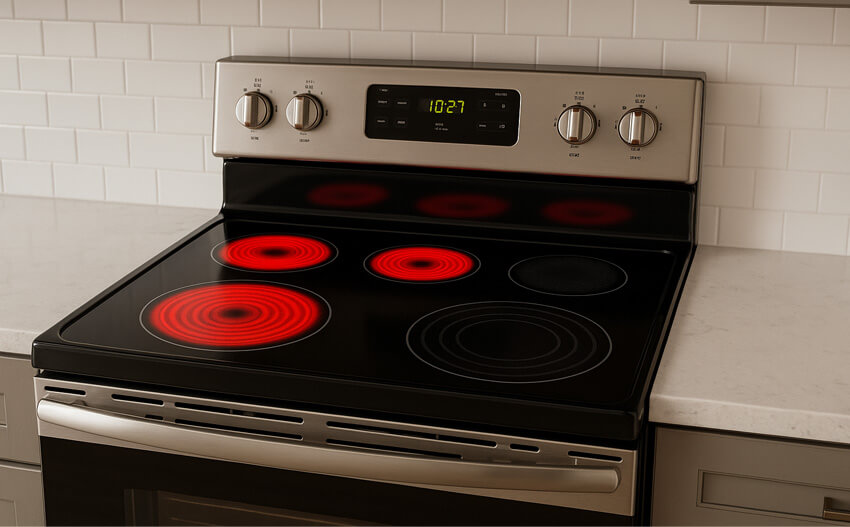Key signs
If a burner does not heat or ignite at all, heats very slowly, shuts off by itself, or shows no spark or glow, you are dealing with a burner not working condition. The control may look normal and the display may not show an error, yet the cooking zone stays cold or the flame never appears.
What it means
A non working burner means power or fuel is not reaching the burner at the right time or in the right amount, or the burner is not able to convert that energy into heat. On electric and induction units this points to a break in the heating path or a control fault. On gas units this points to an ignition or flow problem. It is not a surface issue only. The fault sits in a functional chain that includes safety parts, wiring or tubing, and control logic.
Common reasons
Gas cooktops and ranges
- Igniter does not spark or does not reach the burner cap due to wear or contamination
- Burner ports or jets are blocked by spills or debris which disturbs air and fuel mix
- Weak flame sensor or thermocouple that does not confirm flame and closes the safety path
- Gas valve for the affected burner does not open correctly or delivers low flow
Electric radiant and coil units
- Open heating element or a break in the element connectors so current cannot pass
- Fault in the power switch or infinite switch that selects the heat level
- Wiring fatigue at hot contacts on the burner circuit due to repeated heating cycles
- Protection part or internal fuse that opened after an overload event
Induction cooktops
- Cookware is not compatible or sensor does not see the pan on that zone
- Driver module for that zone has a fault that prevents energy transfer
- Thermal protection limits output because the zone detected excess heat
In many cases the rest of the appliance keeps working. That does not mean the system is healthy. A single failed path can stress nearby parts and create repeat faults.
Safety notes
Stop and ventilate the room if you smell gas or see persistent clicking without flame. Do not continue to attempt ignition in that state. Unusual buzzing, repeated tripping of a breaker, scorch marks near a control, or a burnt smell from the cooktop are also signals to leave the unit off until a technician inspects it. These signs point to risks that are not visible on the surface.
How pros diagnose
A technician begins by confirming that the issue is limited to one zone and then maps the full path of energy for that zone. For gas this includes the ignition sequence, flame sensing, and valve response under normal demand. For electric and induction this includes continuity of the heating path, integrity of connectors, and control signals under load. The goal is to identify the first part in the chain that does not perform within design values rather than replacing several parts at once.
This approach protects the appliance from secondary damage, shortens time to a reliable fix, and avoids guess work that can lead to repeat visits.
Using other burners
You may use other burners only if there is no smell of gas, no repeated clicking, no breaker trips, and no visible heat damage near controls or wiring. If any of these signs appear, keep the appliance off until service inspects it. Shared parts can make a fault in one zone affect others, so pay attention to any change in sound, smell, or heat output while you cook.
What to tell the service
Share the brand and model, which burner fails, how it behaves when you try to use it, and any recent events such as a boil over, a power outage, a circuit trip, or a deep clean. Note the cookware type if the unit is induction. This information helps the technician arrive with the right parts and speeds up the visit.
Expect the technician to provide a clear cause and a written estimate after testing. If the fault is in a safety part or control, replacement with an original part is the right path to restore reliable operation.
Prevention
- Wipe spills at the end of cooking so residue does not harden in ports or around contacts
- Keep burner caps and pans seated correctly to support a stable flame
- Use flat cookware with clean bottoms so sensors read correctly on induction zones
- Allow the surface to cool before cleaning to avoid thermal shock to glass and seals
- Avoid heavy pots on small zones since that strains supports and connectors
These habits reduce stress on parts and help the appliance hold steady performance between regular service visits.






